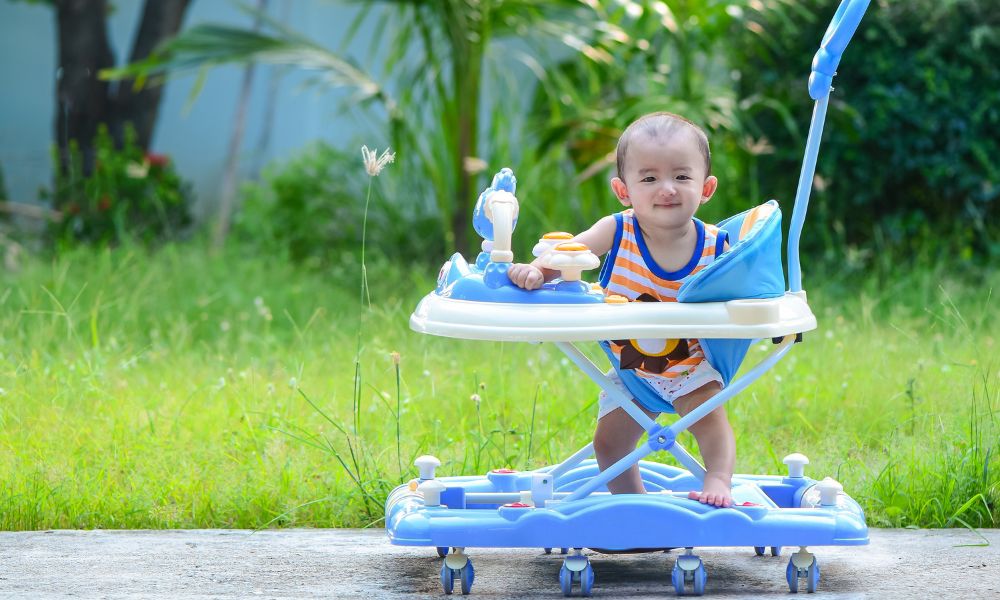Baby walker: Are Walkers Safe for Babies?
As parents, we want to put our trust in the numerous baby items accessible on store shelves and online. However, not all gear is made equal. And some so-called "must-haves" are just harmful, despite their allure. One item may receive varied responses. Baby walker.
They appear cute and amusing. However, countless accidents and events have shown them to be potentially harmful. So, do walkers help to teach babies to walk? If you're considering buying your child a baby walker, keep reading because we will explain the benefits and drawbacks.
What Are Baby Walkers?
A baby walker is a piece of equipment that babies who cannot walk yet (often ages 6 and 15 months) can use to move around spaces on their own. Traditional baby walkers have a seat for babies to sit in, a table, and a broad base with four wheels.
The baby's feet touch the ground. And they can push off the ground with their legs. A push-toy baby walker, on the other hand, is an upward toy. It is a standing baby that can grip on and push ahead. There are two main types of baby walkers available on the market:
- Sit-in baby walker
- Baby push walker /sit-to-stand walker/ activity walker
1. Sit-in baby walker: This is the most common and conventional walker. Creating Sit-in baby walkers for babies who can sit up but cannot support their weight on their legs.
They are typically constructed of a lightweight frame with wheels suspended seat in the center with straps to keep the infant in position.
Babies can drive ahead with their feet in this sort of baby walker. The wheels make it possible to roll around.
2. Baby Push walker, activity walker, or sit-to-stand walker: Design baby push walkers for newborns who can already stand with help. Take a few steps while holding on to something (a process known as "cruising").
A push walker includes a robust frame and a handle that the baby can use to propel the walker. It may also have amusing toys attached to it. Create sounds or operate as a toy shopping cart, lawn mower, or wagon.
Do Baby Walkers Help Babies Learn to Walk?
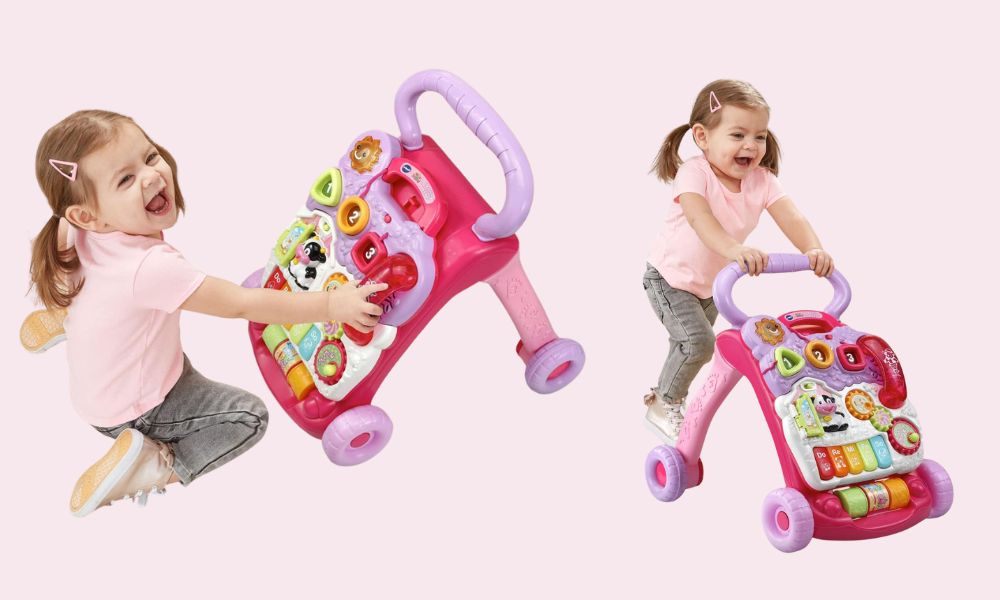
The answer is entirely based on the type of baby walker you are thinking about. We'll look at push walkers and sit-in walkers separately.
According to some studies, using a baby walker can harm a baby's motor development. Baby walkers prevent them from practicing skills like crawling and moving from sitting to standing. Using a baby walker may delay this vital milestone because these skills are necessary for learning to walk.
Furthermore, sit-in baby walkers affect a baby's legs, causing them to be in an abnormal standing position. It can impair muscle development and affect hip joint positioning. They additionally encourage babies to walk on their toes. It can delay the result of a proper heel-toe gait or the necessary balance for separate walking.
However, push walkers (or any other baby product) are unnecessary for your child to learn to walk. Babies have been walking for millennia without any help from toys!
Finally, learning to walk needs more than just leg strength. It also needs the use of a baby's core muscles and balance. Baby walkers do nothing to improve core muscle strength or balance.
Things to Consider When Buying a Walker for Baby
There are a few things to think about when buying a baby walker. To ensure the safety and comfort of your child.
Child: Look for walkers with a broad base and an anti-tip design. And a brake system to keep the walker from rolling away.
Adjustability: Look for a baby walker that can be adjusted in both directions as your baby grows.

Seat: To keep it clean, the center will be comfortable, padded, and machine washable.
Durability: Look for a walker made of solid materials that can withstand regular use.
Activity centers: Some walkers include activity centers that can entertain and stimulate your baby.
Portability: Consider a foldable and lightweight option to travel with the walker.
Weight limit: Check the walker's weight limit to accommodate your baby's weight.
Brand reputation: Consider purchasing from a well-known brand to ensure quality and safety.
Price: Compare the prices and features of various baby walkers to find the best price.
Reviews: Read customer reviews to understand what other parents thought of the walker.
Are Baby Walkers Safe for Babies?
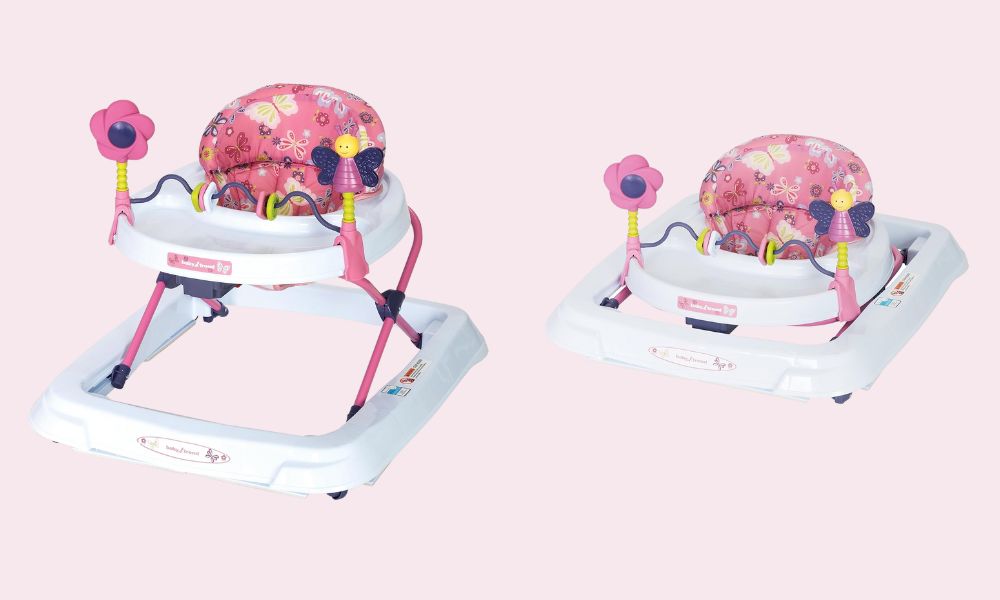
So, are baby strollers safe? You probably notice now that the short answer is no, they're not. According to Paul Patterson, MD, PhD, a pediatrician in Seattle, baby walkers with wheels endanger a child's safety and development. He says that baby walkers with seats are illegal in Canada. And the American Academy of Pediatrics (AAP) has called for a ban likewise.
Because babies can roll along at nearly three feet per second when using baby walkers. At the same time, seeing your child zip across the room like Sha'Carri Richardson may be charming. It can result in severe injuries in the blink of an eye.
Baby walkers can cause severe injuries in many ways. Some of the most common things are the following:
Falling down the stairs: Between 1990 and 2014, over 230,676 children under the age of 15 months were treated for baby walker-related injuries, according to the AAP. A whopping 74% of the injuries are infants falling down the stairs while in a wheel baby walker. If there is any good news, it is the total amount of injuries involving wheeled baby walkers. It has fallen in recent years because parents have become more aware of the risks involved.
Go for the risky things: Walkers help babies reach higher-up objects, such as cleaning supplies and a hot stove. They can pull over, drink boiling water, or grab sharp objects. “Injuries like
- burns
- lacerations
- poisonings
- broken bones
- head injuries
All can happen while parents are watching because parents cannot reach the child quickly enough," Fejt told CNN.
Improper leg development: According to Patterson, baby walkers place a child in an abnormal standing position, inadvertently encouraging external rotation and pointing toes. "This can put unnecessary force on bones. Creating an abnormal walking pattern and affecting regular muscle development," he said.
Moving too fast: Unfortunately, baby walkers can pose a risk even when you're closely supervising. They can pick up speed once the baby learns how to scoot around. "They may quickly run away from a parent or caregiver and reach into an unsafe situation," Alexander said. "What's more, baby can't get out of a walker if an injury occurs." They're trapped.
What Are Some Safe Baby Walker Alternatives?
The best and cheapest alternative is to let your baby learn the old-fashioned way. Begin with tummy time and progress to crawling, standing, cruising, and walking. It is not as exciting or fun as a baby walker. But it is safer.
However, if entertainment is a consideration, Fejt also suggested the following options:
Mats for activities: These enable your baby to explore while strengthening his or her entire body.
Highchairs: While playing with the toys on the tray before them. Your loveable child can see what is going on.
Exersaucers are stationary activity centers: They seem like walkers but do not have wheels. In contrast, they usually have rotating and bouncing seats. Some centers will even transform into play areas once your child has mastered walking.
Push walking toys: Standing walkers are also helpful. But it would help if you kept a close eye on your child when using them when they stand up and start pushing their walker. They use their entire body to propel it forward. This is fantastic for muscle growth.
Baby Walker: A Journey Towards Independent Mobility
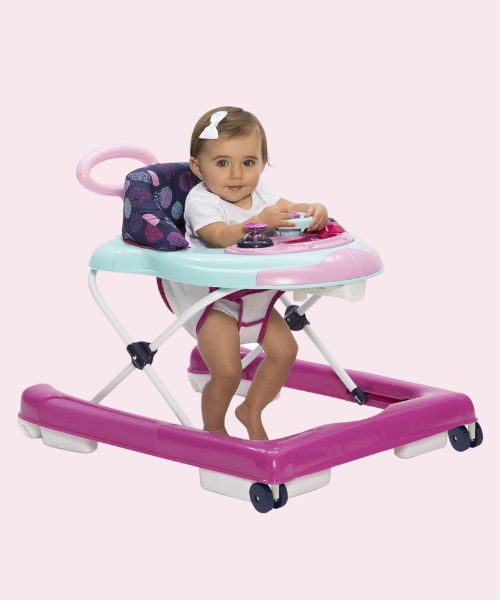
The baby walker is a beloved companion in a child's journey towards mobility. Baby walkers provide an exciting opportunity for little ones to explore and move around independently.
They offer support for babies who are learning to stand and take their first steps. This not only encourages motor skill development but also stimulates their curiosity as they discover their surroundings.
For parents, baby walkers offer the convenience of a safe and contained space for their child to play and explore while providing valuable moments of hands-free time.
Many baby walkers are designed with portability in mind. They are lightweight and easy to move from room to room, allowing parents to keep a close eye on their child as they go about daily tasks.
This convenience ensures that your little one can have their walker wherever they want to explore. With their portability and easy-to-clean features, these delightful devices have become indispensable for both parents and children, offering a world of advantages.
Baby Push Walker: A Stepping Stone to Independence
Baby push walkers serve as both a support and an inspiration for young children who are learning to stand and take their first steps. These walkers provide the stability and confidence needed to help children move around and explore their surroundings.
This not only fosters motor skill development but also ignites their curiosity. Parents find peace of mind knowing that their child has a safe and contained space to practice and play.
They are lightweight and easy to move from room to room, allowing parents to keep a close eye on their child as they go about their daily activities. This ensures that little ones can have their push walker with them as they explore different areas of the home.
Baby Walker with Wheels: A Fun and Developmental Aid
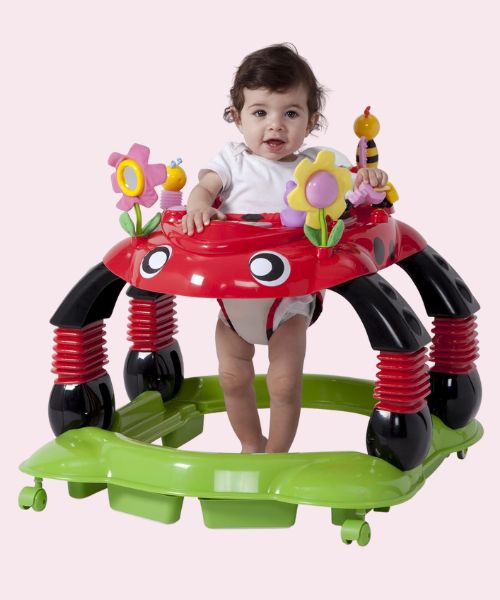
Baby walkers with wheels support and encourage independent mobility and exploration in infants, while providing parents with convenience and peace of mind.
The baby walker with wheels is a delightful and essential tool for babies taking their first steps towards mobility.
Baby walkers with wheels provide crucial support and encouragement for infants who are beginning to explore their world on two feet.
They foster both physical and cognitive development, as they offer stability and freedom of movement.
For parents, these walkers offer the convenience of a safe and contained space for their child to practice and play, all while encouraging them to take their first steps toward independence.
Baby Walker Toy: Playful Steps to Independence
The baby walker toy is not just a plaything; it's a developmental tool that brings joy to both parents and their little ones. Baby walker toys are designed to be more than just fun. These toys offer stability and balance, helping little ones develop their motor skills and coordination. They also foster curiosity and exploration, making the learning process enjoyable.
Many baby walker toys are designed to be lightweight and easy to move around. This means that parents can easily transport them from room to room, allowing their child to explore different areas of the home while staying close. This portability ensures that your little one can enjoy their walker toy wherever they wish to play.
A baby walker can be an excellent tool for teaching your baby to walk. Yet, there is an appropriate age at which they should be allowed to ride the walker. The individual child's development determines the appropriate age for a baby walker.
Babies can typically begin using a walker around the period of 6 months when they can sit up on their own and hold their heads up. At the moment so, are baby walkers safe for children? You've probably realized by now that the short answer is no, they're not. Baby walkers on wheels endanger a child's safety and development.

